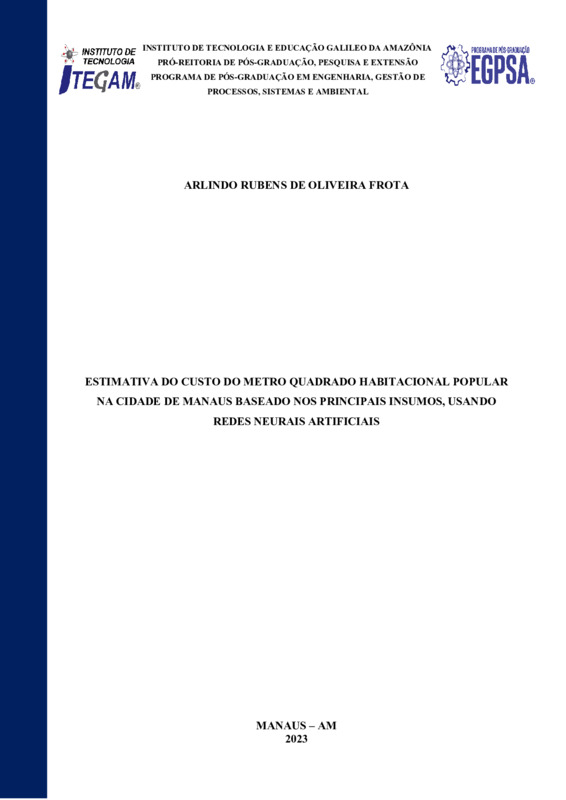-
Tipo do ITEM
-
pt-BR
Dissertação de Mestrado
-
Título da Dissertação ou Tese
-
pt-BR
ESTIMATIVA DO CUSTO DO METRO QUADRADO HABITACIONAL POPULAR NA CIDADE DE MANAUS BASEADO NOS PRINCIPAIS INSUMOS, USANDO REDES NEURAIS ARTIFICIAIS
-
Descrição
-
pt-BR
A construção civil é um dos setores mais expressivos na economia, desenvolvimento e empregabilidade no território nacional. É tido como um dos ramos que demonstra a expansão e riqueza de um país, onde a habitação de interesse social é diretamente ligada ao desenvolvimento socioeconômico. Segundo o IBGE, 2020, Manaus possui 653.618 moradias, sendo que 348.618 são classificadas como aglomerados subnormais, ou seja, palafitas e ocupações insalubres e /ou de difícil acesso. Pode-se afirmar que um dos grandes empecilhos para a construção de residências populares a falta de previsibilidade do comportamento dos custos durante a execução da obra. Esse fator é ainda mais acentuado em loteamentos e complexos habitacionais, ou seja, na produção em massa, por conta da quantidade. Visando atenuar esses desafios, foi implementada uma ferramenta, embasada nos conceitos de RNA - Rede Neural Artificial, a qual compila 2 tabelas de custo da construção civil para prever o custo da habitação popular baseada no valor dos principais insumos. Esta Rede busca estimar o custo do metro quadrado da construção da casa popular na cidade de Manaus. Foi utilizado o software MATLAB®, onde foram compilados os dados das tabelas CUB e INCC. Os insumos utilizados foram os constantes no chamado “lote básico”, preconizado pelo CUB. De forma rápida e praticamente sem custos, a ferramenta desenvolvida pode prever o custo do metro quadrado da habitação popular, na cidade de Manaus, a partir da estipulação dos insumos. A RNA conseguiu apresentar correlação bastante forte nas fontes do seu espaço amostral, demonstrando assim que as tabelas, apesar de apresentarem coleta e tratamento de dados diferentes, além de serem elaboradas por institutos distintos, apresentam compatibilidade nos seus bancos de dados, o que se reflete na veracidade e fidedignidade dos dados coletados e tratados. Após a estimativa de diversos índices estatísticos, nota-se claramente que se trata de uma ferramenta que se mostrou eficiente e segura para a estimativa dos custos futuros.
-
Abstract
-
en
Civil construction is one of the most expressive sectors in the economy, development and employability in the national territory. It is considered one of the branches that demonstrates the expansion and wealth of a country, where social housing is directly linked to socioeconomic development. According to the IBGE, in 2020, Manaus has 653,618 homes, of which 348,618 are classified as subnormal agglomerations, that is, stilt houses and unhealthy occupations and/or difficult to access. It can be said that one of the major obstacles to the construction of low-income housing is the lack of predictability of the behavior of costs during the execution of the work. This factor is even more pronounced in subdivisions and housing complexes, that is, in mass production, due to quantity. In order to mitigate these challenges, a tool was implemented, based on the concepts of ANN - Artificial Neural Network, which compiles 2 civil construction cost tables and predicts the cost of popular housing based on the value of the main inputs. This network seeks to estimate the cost per square meter of construction of popular housing in the city of Manaus. MATLAB® software was used, where data from the CUB and INCC tables were compiled. The inputs used were those contained in the so-called “basic batch”, recommended by the CUB. Quickly and practically without cost, the developed tool can predict the cost of the square meter of popular housing, in the city of Manaus, from the stipulation of the inputs. ANN was able to present a very strong correlation in the sources of its sample space, thus demonstrating that the tables, despite presenting different data collection and treatment, in addition to being elaborated by different institutes, present compatibility in their databases, which is reflected in the veracity and reliability of the data collected and processed. After estimating several statistical indices, it is clearly noted that this is a tool that has proven to be efficient and safe for estimating future costs.
-
Língua do arquivo
-
pt-BR
Português
-
Data da Defesa
-
pt-BR
12/06/2023
-
Palavra-chave
-
pt-BR
Rede Neural
-
pt-BR
Habitação popular
-
pt-BR
Insumos
-
pt-BR
Custo
-
Autor
-
pt-BR
ARLINDO RUBENS DE OLIVEIRA FROTA
-
Orientador
-
pt-BR
Manoel Henrique Reis Nascimento
-
Local
-
pt-BR
Manaus / Brasil
-
Áreas de Conhecimento
-
pt-BR
Otimização de Processos Industriais
-
Turma
-
pt-BR
Turma 01


